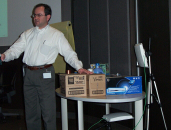March 24, 2003 – Last fall, Alien Technology began selling developer’s kits consisting of antennas, RFID tags and software. But the company found that it was spending a lot of time answering users’ basic questions. So it decided to launch something called the Alien Academy — a two-day seminar for those who want the developer’s kit.
The course is aimed at systems integrators, business partners and potential customers who want to get a deeper understanding of RFID and of Alien’s products. I had the opportunity to attend the course recently and found it to be a valuable experience. Although I’ve been writing about RFID for more than two years, I learned a lot and got some needed hands-on experience.
My 15 classmates had similar reactions. “Alien’s focus on the needs of the end user is what drove my decision to attend Alien Academy,” says Robbin Haley of Morris & Dickson Co., a pharmaceutical distribution company. “The training gives you a running start on overcoming the problems of scanning a diversity of items at once.”
Mark Buckner is a scientist and systems engineer at the Oak Ridge National Laboratory and has a deep understanding of the technical aspects of RFID, but he also came away impressed. “Frankly, it exceeded my expectations,” he says. “It was a well-rounded program. It covered the waterfront, from understanding RF to the software and even some of the systems integration issues.”
The course costs $5,000 and includes the developer kit, which is shipped to you when the course is finished. (Additional developer kits cost $3,000 each.) Some parts of the program would be valuable to business executives working in the supply chain. Some would be useful for engineers who would install readers and figure out the best places to put tags on products. And other parts would be helpful to software engineers and people dealing with system integration.
The course is intense and is not designed for the novice. Business executives that want a crash course in RFID should be sure to read the introductory material that Alien supplies, or spend some time on the RFID Journal site going through the glossary of terms and the frequently asked questions.
The course is not a forum for hyping RFID in general or Alien products in particular. There was just one brief section on Alien’s products. And the instructor, Victor Vega, was frank about the limitations of RFID and the difficulties in tagging products with a lot of metal or water content.
The course is, however, restricted to technology based on the Electronic Product Code system being created by the Auto-ID Center. More specifically, it deals with Class 1 UHF tags. So if you are interested in learning about ISO standards or 13.56 MHz, this course is not for you.
Similarly, the course didn’t touch on the aspects of deploying the technology globally. There was, for instance, no discussion about system performance in Europe and Asia, where limitations on the power output of readers and frequency restrictions can limit read range.
Having said that, the course provided a good grounding in UHF technology. During Day 1, we learned about circular and linear polarized antennas and when each should be used. We learned about the different shapes of antennas and how those affect performance. We learned a great deal about the affects that environmental conditions and the type of product have on the performance of the system.
Students were given the opportunity to map out a reader field, and we were also asked to tag some challenging objects, such as containers of liquid detergent, cans of deodorant and packages of batteries. Students are encouraged to bring samples of their product, so they can figure out what kind of tag to use and where to put it.
I found the first day and half the most useful because it gave me a deeper understanding all the elements that affect the performance of tags in the real world. The discussion of strategies for placing readers and avoiding interference with other readers and other RF devices in the area will be very valuable to those who work in warehouses and stock areas.
The software that Alien provides allows you to attach JPEG or GIF photos of products to their IDs. We learned how to do that, so when you get the developer kit, you can set up a demonstration in which an item is scanned and the photo appears on a screen.
On the last afternoon of the course, Alien’s John Price went into the capabilities of the reader and how they could be programmed with the developer’s kit. He explained how the readers could be managed and programmed. The detailed explanations of the software system and network interface tested the limits of my technical knowledge (and, to be honest, my interest), but one software engineer told me it was the most interesting part of the course for him.
The next Alien Academy will be held on April 15 and 16.


